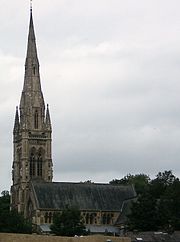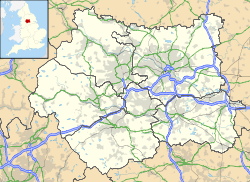- All Souls Church, Halifax
-
All Souls Church, Halifax
All Souls Church, HalifaxLocation in West Yorkshire Coordinates: 53°43′49″N 1°51′46″W / 53.7304°N 1.8628°W OS grid reference SE 091 260 Location Haley Hill, Halifax,
West YorkshireCountry England Denomination Anglican Website Churches Conservation Trust History Founder(s) Edward Akroyd Dedication All Souls Architecture Functional status Redundant Heritage designation Grade I Designated 3 November 1954 Architect(s) Sir George Gilbert Scott Architectural type Church Style Gothic Revival
(13th–14th century)Groundbreaking 1856 Completed 1859 Specifications Spire height 236 feet (71.93 m) Materials Stone, slate roofs All Souls Church, Halifax, is a redundant Anglican church in Haley Hill, Halifax, West Yorkshire, England. It has been designated by English Heritage as a Grade I listed building,[1] and is under the care of the Churches Conservation Trust.[2]
Contents
Early history
All Souls was commissioned and paid for by the local industrialist Edward Akroyd in 1856.[3] The foundation stone was laid on 25 April that year.[4] Akroyd appointed Sir George Gilbert Scott as architect, and the church was completed in 1859. Scott considered it to be his finest church.[2][5] It was intended to be the centrepiece of the model village of Akroydon,[5] and Scott also designed Akroyd's own house and garden, the vicarage and houses for his employees.[3]
Architecture
Exterior
The church is constructed in stone, with slate roofs.[1] The dressings are in magnesian limestone.[4] Its plan is cruciform and its architectural style is of the 13th-14th century.[1] In detail, its plan consists of a nave with a clerestory and north and south aisles, north and south transepts, a chancel with chapels to the north and south, and a south porch. At the northeast corner is a vestry, and in the northwest angle is a tower and spire.[4] Under the tower is a baptistry.[1] The nave measures 87 feet 6 inches (26.67 m) by 54 feet (16.46 m), the transepts 22 feet 6 inches (6.86 m) by 18 feet 9 inches (5.72 m), the chancel 37 feet 6 inches (11.43 m) by 24 feet 3 inches (7.39 m), and the chapels measure 15 feet (4.57 m) by 17 feet (5.18 m). The ridge of the roof is 65 feet (19.81 m) above the floor of the nave.[4] The spire is 236 feet (71.93 m) high.[2]
The tower has four stages, on the top of which is a parapet containing arches, and an octagonal, crocketted pinnacle at each corner. In the upper stage of the tower are double two-light bell openings. The staircase is contained in the wall and the buttress at the northeast corner of the tower. The spire is divided into five stages by moulded bands; in three of the stages are gabled windows. On its summit is a finial and a weathervane. At the west end of the church is a deeply recessed doorway, over which is a tympanum containing sculpture. The south porch contains an arcade of three arches, each containing a single-light trefoil-headed window, and deeply recessed doorways. On the north face of the north transept is a priest's door. The clerestory has 15 windows on each side.[4]
Interior
Internally, between the nave and aisles are arcades with columns made from Derbyshire marble. The piers of the tower and transept arches are made from Aberdeen granite. The church is floored with Minton black, red and chocolate encaustic tiles. The three steps leading from the nave to the chancel are in Nottinghamshire red sandstone. The arcades between the chancel and the chapels are carried on columns of Italian marble. In the chancel is a sedilia, and a credence table built into its wall of the chancel. Between the nave and the chancel is an alabaster plinth carrying a screen in wrought iron.[4] The screen was made by Francis Skidmore.[3] The reredos is in alabaster and contains niches with statues of the Virgin Mary, Mary Magdalene, Mary of Bethany, Saint John, Nicodemus and Joseph of Arimathea. The octagonal pulpit is in Caen stone on a pedestal of Derbyshire marble. The font is square and has a circular bowl. It is made in serpentine from The Lizard and is carried on a pedestal of Aberdeen granite.[4] All the windows contain stained glass.[2] Some of the windows were designed and made by Hardman & Co., and others are by William Wailes, and Clayton and Bell.[4] The organ has four manuals and is currently unplayable and awaiting restoration,[6] but was the largest instrument in the town.[citation needed] The original organ dating from the opening of the building was a small instrument occupying half the space of its successor,[citation needed] the present instrument built in 1868 by Forster and Andrews of Hull to a specification by Edmund Schulze.[7] It was rebuilt and enlarged in 1902 by Norman & Beard.[6] The ring consists of eight bells, all cast in 1859 by G. Mears at the Whitechapel Bell Foundry.[8]
Recent history
The church was declared redundant on 1 March 1979, and was vested in the Trust on 2 August 1989.[9] After the church was declared redundant, the entrance doorway in the south porch was boarded up to prevent vandalism. This was considered to be unsightly, and the Churches Conservation Trust commissioned the design and construction of a set of gates. These are made in iron and have been painted in reddish-brown to complement Scott's design, and the cross and floral motifs have been gilded. At the same time some conservation work was carried out to the surrounding stonework in the porch, and also around the west window. In 2007–08 the Trust carried out more extensive repairs to the church, including some re-roofing to make it weatherproof, and repairs to the stained glass windows and tracery.[3]
See also
- Grade I listed buildings in West Yorkshire
- List of churches preserved by the Churches Conservation Trust in Northern England
References
- ^ a b c d "Church of All Souls, Halifax", The National Heritage List for England (English Heritage), 2011, http://list.english-heritage.org.uk/resultsingle.aspx?uid=1314027, retrieved 15 May 2011
- ^ a b c d All Soul's Church, Halifax Haley Hill, West Yorkshire, Churches Conservation Trust, http://www.visitchurches.org.uk/Ourchurches/Completelistofchurches/All-Souls-Church-Halifax-Haley-Hill-West-Yorkshire/, retrieved 28 March 2011
- ^ a b c d All Souls Church, Haley Hill, Halifax, Churches Conservation Trust, http://www.visitchurches.org.uk/projects/all-souls-church-haley-hill-halifax/, retrieved 14 September 2010
- ^ a b c d e f g h A Description of All Souls Church, Haley Hill, Halifax (3 ed.), Halifax: Whitley & Booth, 1864, http://books.google.co.uk/books?id=3LZAAAAAYAAJ&printsec=frontcover&dq=All+Souls,+Halifax+Haley+Hill&source=bl&ots=4s6vVm-n3F&sig=JmGneCTn20nr4W5epOhHvJx_wsg&hl=en&ei=c8mPTOzvKcP44AbovoCHDg&sa=X&oi=book_result&ct=result&resnum=4&ved=0CB0Q6AEwAzgU#v=onepage&q=All%20Souls%2C%20Halifax%20Haley%20Hill&f=false, retrieved 14 September 2010
- ^ a b A Halifax church with a story to tell, BBC, 27 January 2010, http://news.bbc.co.uk/local/bradford/hi/people_and_places/religion_and_ethics/newsid_8481000/8481292.stm, retrieved 14 September 2010
- ^ a b Yorkshire, West Riding (Yorkshire, West), Halifax, All Souls, Haley Hill (N07206), British Institute of Organ Studies, http://www.npor.org.uk/cgi-bin/Rsearch.cgi?Fn=Rsearch&rec_index=N07206, retrieved 15 September 2010
- ^ Yorkshire, West Riding (Yorkshire, West), Halifax, All Souls, Haley Hill (N04852), British Institute of Organ Studies, http://www.npor.org.uk/cgi-bin/Rsearch.cgi?Fn=Rsearch&rec_index=N04852, retrieved 15 September 2010
- ^ Halifax, Haley Hill, All Souls, Dove's Guide for Church Bell Ringers, http://dove.cccbr.org.uk/detail.php?searchString=Halifax&Submit=+Go+&DoveID=HALIFAX++H, retrieved 15 September 2010
- ^ (PDF) Diocese of Wakefield: All Schemes, Church Commissioners/Statistics, Church of England, 2010, p. 2, http://www.churchofengland.org/media/811168/wakefield%20-%20all%20schemes.pdf, retrieved 3 April 2011
Categories:- Grade I listed buildings in West Yorkshire
- Grade I listed churches
- Church of England churches in West Yorkshire
- Religious buildings completed in 1859
- 19th-century Anglican church buildings
- Anglican congregations established in the 19th century
- Gothic Revival architecture in West Yorkshire
- George Gilbert Scott buildings
- Churches preserved by the Churches Conservation Trust
- Buildings and structures in Halifax, West Yorkshire
Wikimedia Foundation. 2010.


